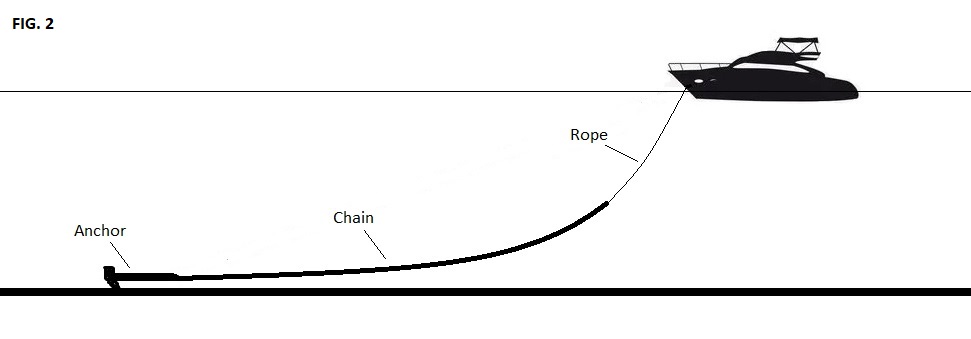Anchoring and Anchor Windlasses
Anchor Rode and Scope
- The rode of the anchor refers to the entire line between the anchor and the vessel. It can be made out of chain, cable, rope, or a combination of these.
- It’s common for chain to be used at the anchor end of the rode because its weight helps to favorably modify the angle from the sea floor that the ship pulls on the anchor. Because of the chain’s weight, it will also help to produce a rode with a greater capacity for dampening the effects of waves and ship movement. Below are two examples of ships at anchor:


- In FIG. 1, if the ship heaves about during wind and waves, it will be prone to apply these forces with similar power to the anchor. This is liable to unseat the anchor and have it drag along the sea floor. If the ship in FIG. 2 were in similar weather, the ship’s movement would have its impact on the anchor dampened by the anchor rode and would have a greater chance at maintaining a secure anchoring.

Anchor Windlasses
- The above diagram shows a typical anchor windlass. Inside the chain locker where the extra chain resides, the end of the anchor chain is fastened to the hull of the ship. This is called the “bitter end”.
- Steps to be taken when lowering the anchor
- Upon receiving an order to prepare the anchor for deployment, inspect the state of the chain in the chain locker. In some chain lockers, it’s possible for the chain pile to tip over and become tangled when pulled upwards through the spurling pipe.
- Assuming the chain is ready to be fed, ensure the brake is on, make sure the windlass is in neutral and declutch the windlass.
- Power up the windlass
- Test forward and reverse
- Clutch in the windlass, release the brake and draw in a small amount of chain so as to take the weight of the anchor chain being mindful of the devil’s claw
- Unfasten the devil’s claw, (if applicable, remove the hawse pipe plug) inspect hawse pipe and chain for any potential impediments
- Inform the bridge that you’re ready to lower the anchor
- Upon confirmation from the bridge to lower the anchor, it should be indicated by the bridge how many shots of chain they want paid out. A shot of chain is 15 fathoms (90 feet) and is also referred to as a shackle. Each shot of chain is commonly denoted on the anchor chain by a painted joining link or kenter shackle.
- Engage the windlass to pay out the chain forward so that the anchor begins lowering in a controlled manner.
- Once the anchor is well clear of the ship, the brake should be engaged once again, the windlass declutched, and the brake can be released in a controlled way so as to pay out the anchor chain with an appropriate speed.
- Note that whenever the brake is disengaged, it is always done with care so that if the chain were to unexpectedly pay out quickly, it can be quickly reengaged.
- As the chain is being payed out, count out the number of anchor shots by watching for the painted shackles and slow down and stop at the desired number. At the passing of each shot, the bridge is to be informed. This is done using the ships bell by sounding one stroke of the bell at the passing of every shot of chain.
- Once the anchor is lowered the desired amount, the brake is once again applied and the anchor chain is monitored to ensure it isn’t dragging. The bridge will need to be informed as to how the chain is vibrating/bouncing and which direction the chain is leading.
- Once satisfied, the windlass is set to neutral and clutched in. The brake may be tightened with a bar at this point to get more leverage.
- Either anchor lights are now to be lit or the anchor ball is to be displayed.
- When raising/weighing the anchor, the reverse of these steps are to be taken with a few differences:
- Be prepared with a hose/shovels for removing debris from the anchor chain or anchor as it comes up from the sea floor.
- Once the anchor is visible, it should be inspected for debris and damage and then hoisted at an appropriate speed back into its stowed position.
- To indicate that the anchor is “aweigh” or in the process of being lifted, the anchor ball is brought down or anchor lights disengaged. Also, there may be a traditional rapid ringing of the ship’s bell.
Anchor Chain Markings
- When lowering the anchor, the amount of chain let out can be measured by reading the anchor chain marks as they pass by. The amount of anchor chain let out is measured in “shackles” (the distance between joining shackles) indicating 15 fathoms or 90 feet. These are typically highlighted by painting the joining shackle. Because frequent use of the anchor can wear off the paint, they are also indicated by the shape and presence of the joining link.
- Another common practice is to put seizing wire (mechanics wire) on the link near the shackle that corresponds to the shackle number. So for example, at the third shackle from the anchor, the third chain link away from the shackle would have seizing wire on it.
